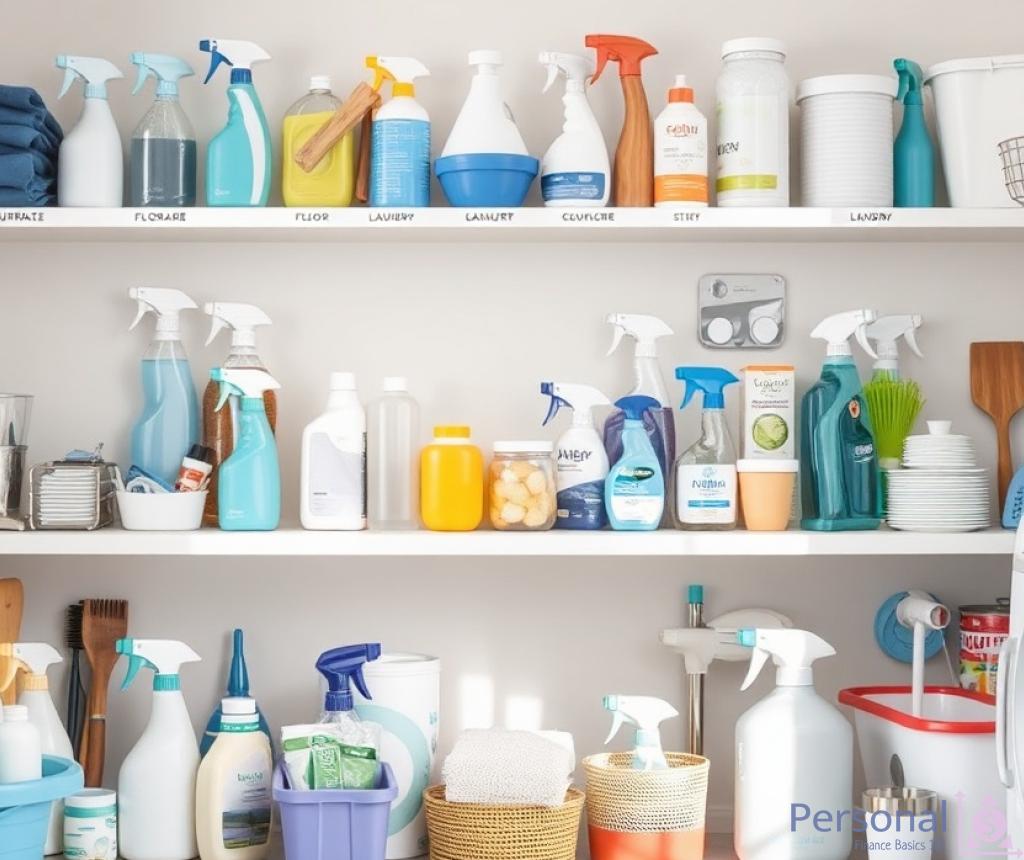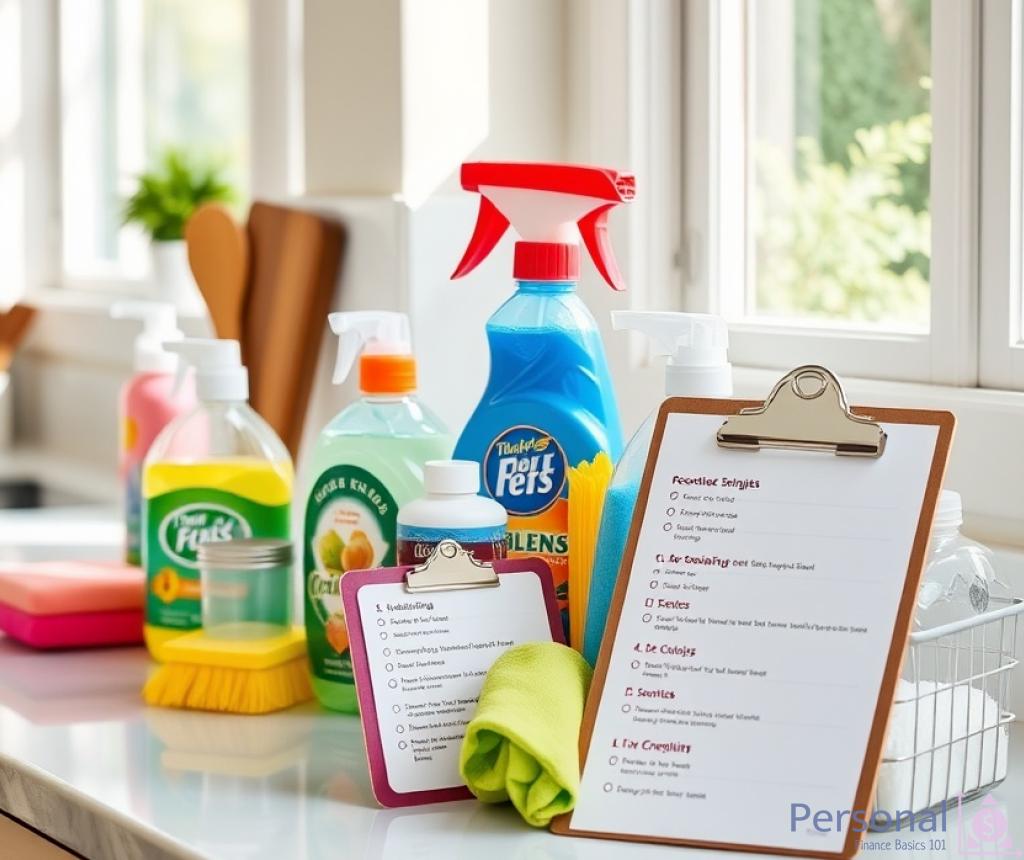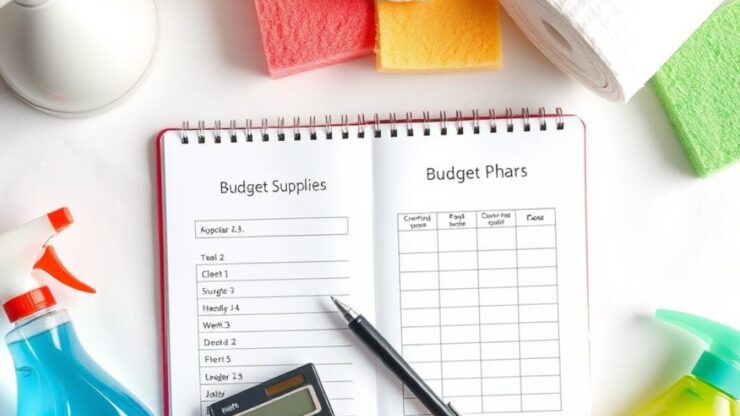Assessing Your Cleaning Needs

Before diving into the specifics of budgeting for cleaning supplies, it’s crucial to establish a clear understanding of your cleaning needs. Knowing what areas of your home require regular maintenance can help you prioritize your purchases and avoid overspending on unnecessary items. Assessing these needs can also lead to a more efficient cleaning routine.
Once you have a grasp on your cleaning objectives, the next step is to identify the essential cleaning products that will fulfill those needs. This involves evaluating the surfaces in your home, the types of messes you encounter, and any specific preferences for cleaning products, such as eco-friendly options. Below is a table that outlines common cleaning supplies along with their intended use and frequency of purchase:
| Cleaning Product | Intended Use | Frequency of Purchase |
|---|---|---|
| All-purpose cleaner | General surface cleaning | Monthly |
| Glass cleaner | Windows and mirrors | Every 2-3 months |
| Bathroom cleaner | Toilets, tubs, and tiles | Monthly |
| Floor cleaner | Hardwood, tile, or laminate floors | Every 2-3 months |
| Dusting spray | Furniture and fixtures | Monthly |
Lastly, a thorough evaluation of your cleaning schedule can greatly influence your budget. By determining how often each area of your home requires cleaning, you can better estimate the quantity of supplies you will need. This assessment can help you avoid purchasing excess products while ensuring that you have enough on hand for effective cleaning.
In summary, assessing your cleaning needs involves understanding your cleaning objectives, identifying essential products, and evaluating your cleaning schedule. This comprehensive approach can significantly impact your budget for home cleaning supplies.
Identifying Essential Supplies

When it comes to managing your home cleaning expenses effectively, pinpointing the essential supplies is a critical step. This process not only aids in cost control but also ensures that you are equipped with the right tools to maintain a clean and healthy living environment. By recognizing which cleaning products are fundamental to your routine, you can streamline your shopping list and avoid impulse buys that accumulate unnecessary costs.
In order to maintain a hygienic space, it is important to focus on versatile and effective products that can tackle a variety of surfaces and messes. Below is a curated list of must-have supplies that will form the backbone of your cleaning arsenal:
- All-Purpose Cleaner: Ideal for a wide range of surfaces, this cleaner can be used for counters, appliances, and more.
- Glass Cleaner: Essential for streak-free windows and mirrors, delivering clarity and shine.
- Bathroom Cleaner: Specialized for tackling soap scum and mildew in showers, sinks, and toilets.
- Floor Cleaner: Depending on your flooring type, a dedicated cleaner will help maintain its appearance and longevity.
- Microfiber Cloths: These are perfect for dusting and cleaning without leaving lint behind.
- Sponges and Scrub Brushes: Necessary for scrubbing surfaces that require a bit more elbow grease.
Before making a purchase, evaluate the versatility of each cleaning product. A single cleaner that can serve multiple purposes can save you both money and storage space. For instance, an all-purpose cleaner that is safe for kitchen surfaces can also be used in bathrooms, reducing the need for specialized products. Additionally, consider eco-friendly options that may provide the same cleaning power without harsh chemicals.
Understanding how often you will need to replenish your supplies is equally important in crafting a budget. The table below outlines common cleaning supplies along with their expected lifespan and suggested replacement frequency:
| Cleaning Product | Expected Lifespan | Replacement Frequency |
|---|---|---|
| All-purpose cleaner | 1-2 months | Monthly |
| Glass cleaner | 2-3 months | Every 2-3 months |
| Bathroom cleaner | 1 month | Monthly |
| Floor cleaner | 3-6 months | Every 3-6 months |
| Microfiber cloths | 1 year | As needed |
Being mindful of the lifespan of your cleaning products will help you budget more accurately and avoid last-minute purchases that can derail your financial plans. By identifying essential supplies, assessing their versatility, and understanding replacement frequency, you can create a practical and realistic budget for your home cleaning needs.
Estimating Costs for Each Item
Crafting an effective budget for home cleaning supplies hinges on accurately estimating the costs associated with each essential item. This step is vital not only for maintaining financial discipline but also for ensuring that your cleaning regimen is adequately supported by the necessary products. By taking the time to research and compare costs, you can make informed decisions that align with your budgetary constraints while ensuring a clean and healthy living environment.
To begin estimating costs, it is essential to evaluate the average prices of the cleaning supplies identified in previous assessments. Pricing can vary significantly based on factors such as brand, product formulation, and purchasing location. For instance, while generic or store-brand cleaners may offer a more economical choice, they can still provide effective cleaning performance. On the other hand, premium brands might introduce specialized formulations, which can be beneficial but often come at a higher price point.
The market for cleaning supplies is diverse, with prices fluctuating based on seasonal promotions, sales, and bulk purchasing options. This variability presents an opportunity to maximize your budget. Engaging in comparative shopping, whether online or in brick-and-mortar stores, can yield significant savings. Many retailers offer loyalty programs or discounts for bulk purchases, which can be particularly advantageous when stocking up on frequently used items.
Additionally, consider the potential for seasonal sales events, such as spring cleaning promotions, which often result in substantial discounts on cleaning products. By strategically timing your purchases, you can optimize your budget and enhance your cleaning supply inventory without overspending.
Once you have gathered pricing information for each essential item, the next step is to calculate your total budget needs. This involves considering your cleaning frequency and the estimated lifespan of each product. For instance, if your all-purpose cleaner lasts about two months, you would need to budget for six bottles over the course of a year. Similarly, understanding the frequency with which you use items like glass cleaner and bathroom cleaner will help you determine an accurate annual expenditure.
It’s crucial to remain flexible in your budgeting process; prices can fluctuate, and unexpected cleaning challenges may arise that require additional supplies. Building a small buffer into your budget can provide peace of mind and ensure that you are prepared for any unforeseen circumstances. By taking a proactive approach to estimating costs and planning your cleaning supply purchases, you can establish a realistic budget that supports your cleaning objectives while keeping your finances in check.
Setting a Monthly Budget
When it comes to maintaining a clean and healthy home, understanding how to allocate your finances effectively is paramount. Establishing a monthly budget for home cleaning supplies allows you to manage your spending while ensuring that you have the necessary products on hand. This financial framework not only helps you track your expenses but also empowers you to make informed purchasing decisions that align with your cleaning objectives.
To set a realistic monthly budget, begin by calculating your expected cleaning supply expenditure. Take into account the essential items identified in your previous assessment, along with their estimated costs. By analyzing your cleaning frequency and the lifespan of each product, you can determine an average monthly outlay. For instance, if you anticipate needing three bottles of all-purpose cleaner each quarter, your monthly budget should reflect this need. This calculated approach allows you to avoid surprises and ensures that you consistently meet your cleaning needs without overspending.
Life can be unpredictable, and having a flexible budget is crucial for accommodating seasonal cleaning needs. During certain times of the year, such as spring cleaning or holiday preparations, your cleaning requirements may increase. It’s wise to build a buffer into your budget to account for these fluctuations. Consider allocating a small percentage of your monthly budget specifically for seasonal items, which may include specialized products or larger quantities of your regular supplies. This proactive strategy not only prepares you for increased cleaning demands but also alleviates financial stress during peak cleaning seasons.
Furthermore, as you refine your budget, consistently track your actual spending against your initial estimates. This ongoing analysis can uncover trends in your cleaning supply usage, enabling you to adjust future budgets for greater accuracy. By staying attuned to your purchasing habits, you can create a sustainable budget that supports both your cleaning objectives and your financial well-being.
Tracking Expenses and Adjusting the Budget
In the quest for maintaining a pristine living environment, tracking your expenses is an essential aspect of managing your budget for home cleaning supplies. By keeping a close eye on your spending habits, you can ensure that you remain within your financial limits while still having access to the necessary products. This practice not only promotes financial responsibility but also enhances your overall cleaning strategy.
To effectively manage your cleaning supply budget, it’s crucial to first understand your spending patterns. Regularly reviewing your expenses allows you to identify trends and areas where you might be overspending. By categorizing your purchases—such as essential items, seasonal products, and occasional splurges—you can gain insights into your cleaning habits.
Once you have a clear picture of your spending, the next step involves adjusting your budget accordingly. Implementing the following strategies can help you maintain a balanced budget while ensuring that you meet your cleaning needs:
- Evaluate Necessity: Regularly assess whether each cleaning product is essential. Eliminate any non-essential items that may be inflating your budget.
- Explore Alternatives: Research alternative products that may offer similar cleaning efficacy at a lower price point.
- Leverage Discounts: Take advantage of sales, coupons, and bulk purchase discounts to minimize costs.
- Seasonal Adjustments: Be flexible with your budget during peak cleaning seasons, allowing for additional expenses that may arise.
By implementing these strategies, you can create a more adaptive budget that responds to your real-time cleaning supply needs without sacrificing quality.
Finally, it’s important to adopt a mindset of continuous monitoring and revision. As you track your expenses over time, periodically reassess both your cleaning habits and budget allocations. Are there products that you no longer use? Are you consistently under or over budget? This ongoing evaluation will empower you to make informed decisions that align your cleaning objectives with your financial capabilities, ultimately leading to a more organized and efficient cleaning routine.
Disclaimer
This article has been created or edited with the support of artificial intelligence and is for informational purposes only. The information provided should not be considered investment advice. Please seek the support of a professional advisor before making any investment decisions.






